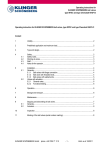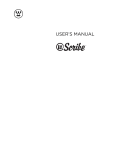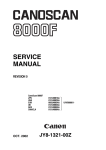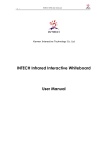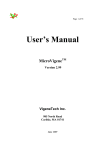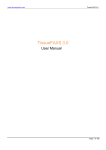Download Operating instructions for KLINGER SCHÖNEBERG ball valves, type
Transcript
Operating instructions for KLINGER SCHÖNEBERG ball valves type RK-Chemoball, type RK-Proball, type RK-Ecoball Operating instructions for KLINGER SCHÖNEBERG ball valves, type RK-Chemoball, type RK-Proball and type RK-Ecoball Contents 1 Validity................................................................................................................... .................... 2 2 Authorised use and maximum loading.................................................................. .................... 2 3 Type models.......................................................................................................... .................... 2 4 4.1 4.2 4.3 4.4 5 5.1 5.2 Safety.................................................................................................................... Safety instructions................................................................................................. Work on the valve................................................................................................. Personnel.............................................................................................................. Instructions for the operator.................................................................................. .................... 2 .................... 2 .................... 3 .................... 3 .................... 4 Installation............................................................................................................. General................................................................................................................. 5.1.1 Ball valves with flange connection........................................................... 5.1.2 Ball valve with threaded ends.................................................................. 5.1.3 Ball valves with butt weld ends................................................................ Valves with actuators............................................................................................ 5.2.1 General instructions................................................................................. 5.2.2 Functional testing.................................................................................... .................... 4 .................... 4 .................... 5 .................... 5 .................... 5 .................... 6 .................... 6 .................... 6 6 Operation.............................................................................................................. .................... 6 7 Storage and transport........................................................................................... .................... 6 8 Maintenance.......................................................................................................... .................... 7 9 9.1 9.2 10 Putting out of action and disassembly of ball valves............................................. .................... 7 General................................................................................................................. .................... 7 Actuators............................................................................................................... .................... 8 Inspection.............................................................................................................. .................... 8 KLINGER SCHÖNEBERG GmbH phone +49 72 55 71 17-0 -1 - Valid from01/2010 Operating instructions for KLINGER SCHÖNEBERG ball valves type RK-Chemoball, type RK-Proball, type RK-Ecoball 1 Validity These operating instructions are applicable to the valves given below: RK-Chemoball KH2F, KH3WF RK-Proball KH 1T M, KH 1T W, KH 2T M, KH 2T E, KH 2T K, KH 2T K-HP, KH 2T F, KH 3T M, KH 3T S, KH 3T SV, KH 3T F, KH 3W M, RK-Ecoball KHe 1T M, KHe 2T M, KHe 2T E, KHe 2T K, KHe 2T F, KHe 3T M, KHe 3T S 2 Authorised use and maximum loading Ball valves are valves with an “open-closed” function. They must be used only for approved media under approved pressure and temperature conditions. If the permissible technical parameters, such as pressure or temperature, are not observed, or if media are used which are not suitable for the valve material, a guarantee of safety is no longer possible. The valves must not be used at pressures and temperatures higher than the limit values given in the relevant technical data sheet. This causes overloading of the valves which they cannot withstand. In this case the manufacturer accepts no responsibility for the consequences. Possibly occurring pressure surges (water impact) should not exceed the maximum permissible pressure. Suitable protective measures must be taken to prevent this. With driven valves it is absolutely essential that the specified connected loads are observed - also the installation and maintenance instructions, as well as the operating instructions for the drive. 3 Type models Actuation: The ball valves are actuated by a hand lever, a gear or by means of a pneumatic or electrical actuator. Connection: The ball valves are connected by a flange, thread or butt weld ends (see respective data sheet). Special models: Use a suitable special model if there is danger of an electrical discharge, in contact with oxygen, if leakage monitoring is required, if there is danger of frost or fire or at high temperatures. 4 Safety 4.1 Safety instructions • • • • If these safety instructions are not followed all claims for damages are forfeited. In addition to the safety instructions given in these operating instructions the existing national regulations for prevention of accidents, as well as the occupational, operating and safety instructions of the operating firm, must also be observed. When using the valves acknowledged technical rules must be observed, e.g. standard specifications, leaflets and work sheets, VDI – VDE (Association of German Engineers, Association of German Electrical Engineers) directives etc. With plants requiring monitoring the important relevant laws, directives and technical rules must be observed. Actuation of the ball valves should be uniform and not too fast, since movements which are too fast or jerky can cause overloading of the system through medium surges (water impacts). KLINGER SCHÖNEBERG GmbH phone +49 72 55 71 17-0 -2 - Valid from01/2010 Operating instructions for KLINGER SCHÖNEBERG ball valves type RK-Chemoball, type RK-Proball, type RK-Ecoball • • 4.2 Work on the valve • • • 4.3 Heating or cooling should not be too fast in order to prevent overloading of the material through ununiform temperature distribution If pneumatic or electro-mechanical drives are used safety of the operating or maintenance personnel should be ensured since with these drives there is a danger of pinching or squeezing. If necessary guards should be fitted. Work on the valve should be carried out only in a depressurized and cooled state. At the same time the temperature of the medium should be below the evaporation temperature in all areas coming into contact with the medium. Work on (driven) valves should be carried out only with the system at a standstill. It is absolutely essential that the procedure for shutting down described in the operating instructions is followed. Valves which come into contact with media which are detrimental to health must be decontaminated. Immediately after completion of the work all safety devices and guards must be refitted or put back into operation. Personnel The valves should be used only by expertly trained personnel. KLINGER SCHÖNEBERG ball valves have been manufactured according to the current state of the art, and are reliable and safe to operate. However, these valves can be dangerous if they are used by untrained personnel or are used improperly, since they are comparable with pressure vessels. The following points must therefore be observed. • • Personnel must be expertly trained. The operating firm must ensure that the contents of the operating instructions have been completely understood by personnel. • Personnel responsible for operation, servicing and installation must understand the interactions between the valve and plant. • Faulty operation of a valve can lead to serious consequences, e.g.: • Leakage of medium • Standstill of the plant / machine • Impairment (reduction / increase of the effect / function) of the plant / machine • Failure of important functions of the valve / plant • Failure of specified methods for maintenance and repair • Endangering of persons through thermal, electrical, mechanical or chemical effects • Endangering of the environment through leakage of dangerous materials Improper handling can cause danger to persons, property and the environment through leaking medium. Therefore, in addition to observing these operating instructions, all relevant accident prevention regulations and technical rules must also be followed. 4.4 Instructions for the operator • • If hot or cold valve components cause danger (e.g. housing components or hand lever) these components must be guarded to prevent contact/touching by the operator (customer’s obligation) Leakage (e.g. spindle sealing material) of dangerous conveyed material (e.g. explosive, toxic, hot) must be removed in such a way that there is no danger to persons and the environment. Legal regulations must also be observed. KLINGER SCHÖNEBERG GmbH phone +49 72 55 71 17-0 -3 - Valid from01/2010 Operating instructions for KLINGER SCHÖNEBERG ball valves type RK-Chemoball, type RK-Proball, type RK-Ecoball • Danger from electrical energy must be eliminated (for details see, for example, the regulations of the VDE and local power supply companies). KLINGER SCHÖNEBERG GmbH accepts no liability for damage or faults occuring during operation which are caused through improper handling or non-observance of these operating instructions, as well as for any changes made to the valves without agreement with the manufacturer. 5 Installation 5.1 General The ball valves can be installed at any required position using normal pipe installation methods. Care should be taken that the ball valves are easily accessible for operation. Any direction of flow can be installed (with the exception of types with pressure relief drill holes). The ball valves can also be installed where there is a change in the direction of flow. Ball valves with a specified direction of flow are marked accordingly by means of an arrow. Valves and pipes which are operated at high (> 50°C) or low (< 0°C) temperatures must be protected against contact by insulation, or an appropriate sign indicating the danger on contact must be provided. If condensation water is formed or there is danger of icing up in air-conditioning units, cooling or refrigeration plants, suitable diffusion-resistant insulation of the complete valve is necessary, possibly also including the hand lever. If ice is formed there is a risk that the actuating function of the valve will be blocked. In such cases please enquire about “low temperature version” special types. If a ball valve is installed in a pipe as the terminal valve this should be secured against unauthorised or accidental opening using suitable measures. This will avoid damage to persons or property since there is a danger of injury on closing the valve. During installation no static or dynamic forces should act on the ball valve. The ball valves should not be used as a fixed point on the pipe. Damaging tensile, pressure or bending forces must be kept away from the valves, in order to avoid seal leakage and fracture of the housing. The plastic caps should not be removed until shortly before installation of the ball valve. The pipe must be rinsed to remove dirt, scale, burr, zinc and welding residues etc, since otherwise this can cause damage to the ball or seals. 5.1.1. Ball valves with flange connection During installation it is particularly important to ensure parallelism of the pipe flange and perfect close fitting. Only suitable screws, nuts and seals should be used. If necessary the relevant installation instructions for fitting the seals, as well as media and temperature compatibility, are to be observed. The seals must be properly centred. The screws must be tightened crosswise using the specified torque. 5.1.2. Ball valves with threaded ends Connection according to EN 10226-1: The valve is connected to the pipe with a internal screw thread, according to EN 10226-1. This is a system in which the pipe thread seals into the connecting thread. Fittings or pipes with a tapered outside thread and a suitable sealant are to be used as counterpart. KLINGER SCHÖNEBERG GmbH phone +49 72 55 71 17-0 -4 - Valid from01/2010 Operating instructions for KLINGER SCHÖNEBERG ball valves type RK-Chemoball, type RK-Proball, type RK-Ecoball Connection according to EN ISO 228-1: The screw connections have a internal screw thread according to EN ISO 228-1. This is a system in which the pipe thread does not seal into the connecting thread. Fittings or pipes with a cylindrical outside thread and a seal are required, for example, as counterpart. The seal should be inserted between the supporting surface of the flange sleeve and the flat front surface of the counterpart and then compacted. The sealing surfaces must be metallically clean and dry. Suitable seals should be used (pay attention to temperature and medium resistance), and the relevant applicable installation instructions are to be observed. The housing of the ball valves has an attached hexagon on both sides. This enables the the ball valve to be held in the required installation position by means of a suitable tool when screwing in the counterpart, and the screwing forces can be countered. 5.1.3 Ball valves with welded connection These ball valves are suitable for use with the gas and arc welding processes. Proper sealing can be guaranteed only if welding has been carried out expertly. Extended butt weld ends The construction length is selected in such a way that, with correct execution of the weld the complete valve can be welded in. The following points must be observed here: • • • • Tack weld the ball valve in the pipe with at least 3 welding spots (offset at 120°) Weld together – colour-change crayons are recommended for checking the temperature. The temperature during preheating and welding should not exceed 200°C in the area at the edge of the housing. Cooling during the welding operation is advisable. After the weld seam has cooled down the housing screw connections are tightened with the specified torque (see technical data sheet). Carry out a functional check. Butt weld ends • Tack weld the ball valve in the pipe with at least 3 welding spots (offset at 120°) per connection. • Dismount the ball valve and mount a spacer in its place. • Weld the connections completely and allow to cool. • Remove the spacer and mount the ball valve. In doing so observe the specified torques for the housing connecting screws (see technical data sheet). • Carry out a functional check. 5.2 Valves with actuators 5.2.1 General instructions Electrical lines must be connected only by competent persons. The VDE 0100 and VDE 0165 (Explosion Protection) regulations are to be observed. All electrical devices, such as servo drives, switch boxes, solenoid valves, limit switches etc must be installed in dry areas protected from flooding. The voltage and frequency must correspond to the data given on the name plate. If the user fits a self-automation system the mechanical stops must be removed. 5.2.2 Functional testing The shutting off function should be tested by operating several times. For valves with electrical and pneumatic drives the regulating distances / forces must be limited. For this the operating instructions of the drive manufacturer must be followed. KLINGER SCHÖNEBERG GmbH phone +49 72 55 71 17-0 -5 - Valid from01/2010 Operating instructions for KLINGER SCHÖNEBERG ball valves type RK-Chemoball, type RK-Proball, type RK-Ecoball 6 Operation The ball valve is opened and closed by turning the hand lever or the control shaft through 90°. The valve closes when turned to the right (clockwise). The ball valve is opened when the hand lever is positioned parallel to the pipe. If the hand lever is removed the position is indicated by the dihedron (valve open when dihedron is parallel to the pipe). Ball valves are not suitable for regulating the flow. The hand lever should be operated slowly. If a medium with extremely high expansion through temperature change is used pressure relief must be provided. For this please follow the relevant operating instructions. If pressure is relieved by drilling a hole the ball valve can be operated only in one direction of flow. If the ball valve is used for a purpose other than that for which it was intended, e.g. continuous use in the throttling position, this will cause increased wear. If the hand lever is used improperly, for example by using a lever extension, or if it is used as a climbing aid, correct functioning will be impaired. If the valve is not operated for a long period the actuating moment may have to be increased. To remedy this we recommend regular functional checks. If the surface is damaged through impact or friction this can cause corrosion, and can therefore lead to a reduction in the service life. 7 Storage and transport Ball valves should be stored in a dry place, protected from contamination. When loading and unloading, as well as during transport of the valves, care should be taken that the ball valves are not thrown or knocked, in order to avoid damage. Covers which may have fallen off should be cleaned and replaced. The ball valves have been protected against corrosion before leaving the works. The ball valves must be stored in the opened position. The plastic caps should not be removed. The ball valves should be protected against environmental influences, such as moisture, wetness, rain, dust, dirt, sand, mud, salty air or drizzle and salt water. During storage temperatures should not drop below or exceed the values – 20°C to + 50°C. Rapid changes in temperature should be avoided as far as possible (development of condensation water). Lubrication is recommended following long storage (caution – not with the oxygen model). The ball valves should subsequently be opened and closed at least twice. For valves with single-acting actuators (e.g. pneumatic actuators with spring closed or similar system), in which the “closed” position is required as final position in a pressureless state of the control circuit, it is permissible to supply the valve in the closed position. If necessary the valve should be cleaned before installation. Specially actuated valves with mounted solenoid valves and limit switches must be treated extremely carefully. The packing should be removed preferably shortly before installing. Do not knock heavy valves on hand levers or mounted components. 8 Maintenance If used properly KLINGER SCHÖNEBERG ball valves are maintenance-free. Correct functioning and sealing should be checked at regular intervals. If maintenance is required please observe the following points: Maintenance work should be carried out only by trained specialists. If maintenance is carried out while the valves are in operation, there must be no residual pressure in the line and in the ball valve. The ball valve should be opened and closed at least once in order to ensure that the dead volume is also no longer under pressure. KLINGER SCHÖNEBERG GmbH phone +49 72 55 71 17-0 -6 - Valid from01/2010 Operating instructions for KLINGER SCHÖNEBERG ball valves type RK-Chemoball, type RK-Proball, type RK-Ecoball In case of leakage correct fitting of all screws should be checked. Furthermore it should be checked whether the ball valve is 100% closed. If this is not the cause of leakage the ball valve must be dismantled (for this see repair instructions). 9 Putting out of action and disassembly of ball valves 9.1 General During long standstill periods liquids which change their state through changes in the concentration, polymerisation, crystallizing out, solidification or similar processes must be drained off from the pipe system. If necessary the pipe system, including the valves, must be rinsed. Before dismantling the complete valve from the pipe, or before repairs and maintenance work on the valve itself, the complete valve must be depressurized and cooled down to such an extent that the temperature drops below the evaporation temperature of the medium in all regions coming into contact with the medium. In this way the danger of scalding is eliminated. Disassembling of valves under pressure is dangerous to life ! If media have been conveyed which are toxic, easily inflammable, or have residues which cause corrosion danger with atmospheric moisture, the valve must be drained off, rinsed and/or ventilated. Residual liquid which may have been left in the valves owing to the installation position should be collected and disposed off as waste. If necessary wear a mask and protective clothing. The valves should be carefully rinsed and drained off before transporting. If the ball valves are returned to the manufacturer they must be delivered in a state free of contamination. 9.2 Actuators If drives which are fed by an outside power supply (electric or pneumatic) are dismantled from the valves, or are themselves dismounted, the outside power should be switched off before beginning this work and the instructions relating to the drive should be followed. 10 Inspection Since the seal can become damaged through abrasion, the ball valve should be regularly checked for proper sealing. If the ball valve is dismantled it is essential that the relevant KLINGER SCHÖNEBERG repair instructions are observed. Subject to changes in design and construction without notice if this is in the interests of technical progress. KLINGER SCHÖNEBERG GmbH phone +49 72 55 71 17-0 -7 - Valid from01/2010







